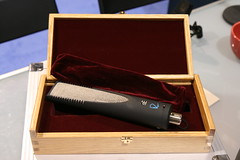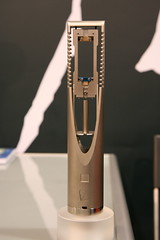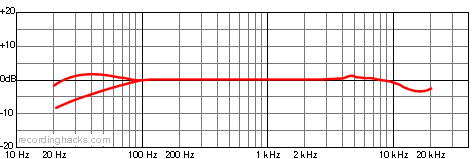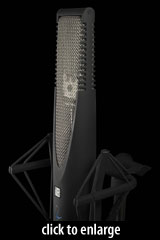 SE Electronics RNR1
SE Electronics RNR1
Bidirectional Active Ribbon Microphone
The RNR1 is an active ribbon mic developed in a collaboration between Rupert Neve (of Rupert Neve Designs) and Siwei Zou (of sE Electronics). It was introduced at the AES show in San Francisco in late 2008, was in the final stages of QA at Neve’s shop during NAMM in January 2009, and began shipping by the second quarter of 2009.
 We got the story on the RNR1 from Bob Reardon, Managing Director of sE Electronics’ US Distributor at the time, Sonic Distribution, at the Winter NAMM show in January, 2009. In the video, Bob gives some background on the mic’s construction and on the dual-transformer architecture of the amplifier circuit.
We got the story on the RNR1 from Bob Reardon, Managing Director of sE Electronics’ US Distributor at the time, Sonic Distribution, at the Winter NAMM show in January, 2009. In the video, Bob gives some background on the mic’s construction and on the dual-transformer architecture of the amplifier circuit.
 The mic’s case and ribbon transducer were developed by Siwei and the sE staff. Neve provided the active electronics and transformers. Of the electronics, Neve stats that the concepts were derived from his 5088 console; he describes the approach as “Class A, single-sided, discrete components.”
The mic’s case and ribbon transducer were developed by Siwei and the sE staff. Neve provided the active electronics and transformers. Of the electronics, Neve stats that the concepts were derived from his 5088 console; he describes the approach as “Class A, single-sided, discrete components.”
 There are two transformers within the RNR1’s circuitry; one between the ribbon transducer and the amplifier circuit, to optimize the impedance loading of the ribbon, and another on the output of the amp circuit.
There are two transformers within the RNR1’s circuitry; one between the ribbon transducer and the amplifier circuit, to optimize the impedance loading of the ribbon, and another on the output of the amp circuit.
Rupert Neve
The ribbon has a very small impedance, and we need to step that up with a transformer of sufficient quality that it doesn’t lose anything. This goes into the amplifier, then we have an output transformer that is almost identical with the ones we used 40 years ago; smaller in size, but doing the same job.
Although sE has not released test results yet, Rupert Neve has been quoted as stating that the RNR1 will be able to handle 140dB SPL.
The machining of the case, manufacturing and tuning of the ribbon motor are done at the sE factory in China. The circuit boards and transformers are built at the Neve factory in the US, then shipped to sE’s plant for final assembly.
 One of the key benefits of the microphone’s circuit design is its high-frequency response. With the exception of some of the Crowley and Tripp ribbon mics, most ribbons have attenuated high ends. The RNR1 is another exception to the rule; the claimed frequency range extends to 25kHz, and although there is a -3dB dip centered at 15kHz, the mic’s response is actually rising at 20kHz rather than dropping off.
One of the key benefits of the microphone’s circuit design is its high-frequency response. With the exception of some of the Crowley and Tripp ribbon mics, most ribbons have attenuated high ends. The RNR1 is another exception to the rule; the claimed frequency range extends to 25kHz, and although there is a -3dB dip centered at 15kHz, the mic’s response is actually rising at 20kHz rather than dropping off.
ProAudioReview, 2009
[Recording] a choir in a large church, the results were truly stunning. Results were as close to being “in the space” as I have heard. That wasn’t simply due to the usual ribbon characteristics of warm lows and spacious mids, but also an added level of detail that extends right through the high frequencies. This high frequency detailing is an area that ribbons often seem to struggle with; in the case of the RNR1, there were no problems at all.
SoundOnSound, 2009-05
The frequency response of a typical ribbon mic rolls off steeply above 10kHz, with little or nothing left above 16kHz. If you look at a [frequency response] plot of the RNR1, you’ll also see a roll-off above 10kHz, running into a significant dip centered at 16kHz, but … the response simply dips and then comes up again by 20kHz, and extends as far out as 25kHz. According to Mr Neve, the 20–25kHz region is very important, because although those frequencies can’t be heard in isolation, they have a significant impact on the way frequencies in the 8–12kHz range are perceived. [I]n comparison with a number of other well-known ribbon mics… the RNR1 presented a real sense of ‘air’ and definition. At the same time, the character of the sound was unmistakably ‘ribbon’ — warm and comfortable to listen to, with a smooth, non-fatiguing character…
Of the ribbon mics we tried, the RNR1 seemed to me to come out top — or at least very close to the top — in the majority of applications, although it must be said that the AEA R44 also sounded excellent, with its warm lower registers and smooth, silky high end.
The SE RNR1 was part of our massive Ribbon Mic Shootout in 2011.
Permalink: SE Electronics RNR1
The mic was released in 2009.
Specifications
| Frequency Response - BidirectionalClick Graph to Compare! |
|---|
 |
| Pickup Patterns | Pads & Filters |
|---|---|
|
Bidirectional
(25 mV/Pa; 20 - 25,000 Hz) |
|
| Ribbon Construction | Impedance | SPL/Noise |
|---|---|---|
| 2.5-micron aluminum ribbon | 200 Ohms (Low) | Max SPL: 135 dB Self-noise: 15.0 dB(A) |
| Weight | Length | Max Diameter | Interface(s) |
|---|---|---|---|
| 850g (29.98oz) | 265mm (10.43'') | 47mm (1.85'') |
|
| Power Specifications |
|---|
|
Did we get anything wrong on this page? Please let us know!


